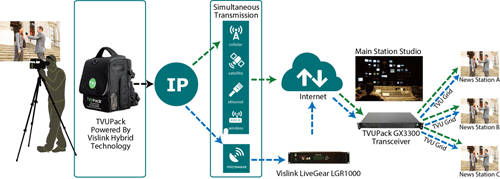Vislink and TVU Bond ENG Paths for Improved Reliability
In the days of analog microwave, doing an HD remote was tricky at best and usually impossible. Once broadcasters fit up with digital microwave (mostly as a result of the Sprint BAS relocation project), the COFDM gear made remotes more reliable and ready for HD.
However, "more reliable" doesn't mean that it always worked. Although COFDM consistently has let broadcasters get shots where their old analog gear would have failed, there are still situations where even COFDM won't get through.
Thus the announcement earlier this week that Vislink and TVU have partnered to provide an ENG remote system that bonds both digital microwave with cellular LTE networks for a more bulletproof link that will work in places where one or the other might fail.

"We are simultaneously aggregating both cellular and microwave connections together with our TVUPack TM8200," said Dan Sorensen, senior marketing communications manager for TVU Networks. "You can add or drop any of the microwave or cellular connections without interrupting the transmission, which means that you can keep transmitting even if the cellular or microwave bandwidth completely drops out."
DEAD ZONES
There are always pockets where ENG microwave and cellular LTE will not work, and it's certainly possible for a news vehicle or camera operator to be in a spot where neither works. However, having a redundant path with auto-changeover will improve reliability.
One application for this is in locations where BAS microwave will simply not work because of terrain or distance. For example, a station may be able to make a live news feed from a neighboring city where there is no chance of getting microwave back to the studio.
The TVU/Vislink solution starts with a TVUPack 8200 that has been modified with Vislink hybrid technology. This can send data signals over a variety of networks, including cellular, satellite IP and WiFi, and it also provides a connection to a station's microwave network directly from the backpack. With the right gear, it could use an ENG truck to relay the microwave signal in instances where the backpack can't reach a receive location.
Back at the station, the microwave receiver passes the signal to a Vislink LiveGear LGR1000, while the data from other networks all arrive at the station via the Internet cloud. All this data is processed by a TVUPack GX3300 transceiver, and the video/audio signal is supplied to the station in the desired format.
The role of bonding Vislink and TVU's gear is that all the signals arrive back at the station synchronously, providing path redundancy and ensuring more reliability.
Although the bonding of the cellular and microwave systems is new, it doesn't require completely re-outfitting your gear if you already have some of the components.
"The microwave transmitter is incorporated into the modem module of the TVUPack TM8200," Sorensen said. "Existing 8200s can be upgraded, so there is no need for customers to purchase a different TVUPack transmitter."
NEARLY EXTINCT
Highly skilled ENG technicians are becoming extinct, and stations are relying on intelligent but not necessarily highly trained staff to be capable of establishing an ENG link. TVU and Vislink say that this new system will be simple and easy to set up.
"One of the primary design philosophies for the TVUPack is that it be simple to operate in the field so photographers can focus on getting the shot instead of configuring ENG gear. TVUPack has a simple one button operation," Sorensen said. "When the power button is pushed, the system boots up in less than 20 seconds and automatically connects with any available cellular or microwave networks. The TVUPack will aggregate all available bandwidth from each connection and transmit the video back to the production facility."
One of the sticky problems with the changeover to digital microwave a few years ago was the increased difficulty of getting IFB signals from the station back to the camera operator and news talent. Since LTE, WiFi and other networks are bi-directional, they can deliver decent bandwidth back from the Internet to the camera operator. This includes IFB and audio foldback.
"The solution basically makes the TVUPack an IP bridge to the microwave link," Sorensen said.
If absolute reliability is critical for your ENG feeds, the increasing availability of high-speed cellular networks may be one route to reliability nirvana.
Get the TV Tech Newsletter
The professional video industry's #1 source for news, trends and product and tech information. Sign up below.
Bob Kovacs is the former Technology Editor for TV Tech and editor of Government Video. He is a long-time video engineer and writer, who now works as a video producer for a government agency. In 2020, Kovacs won several awards as the editor and co-producer of the short film "Rendezvous."

